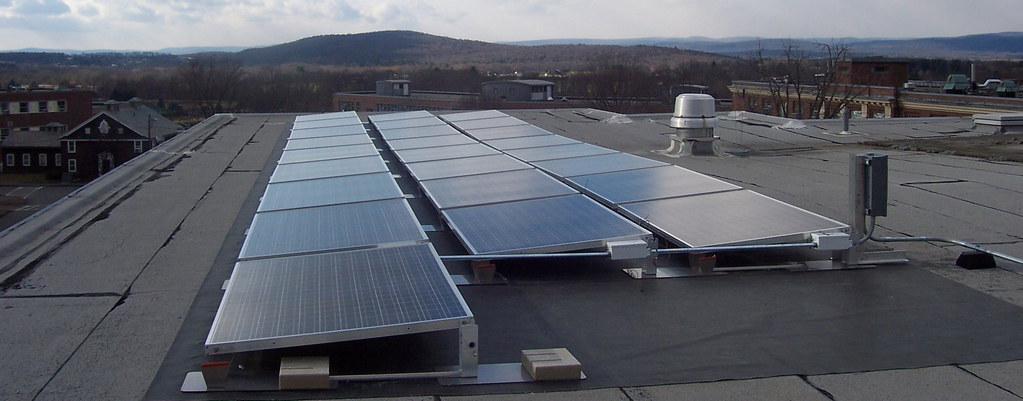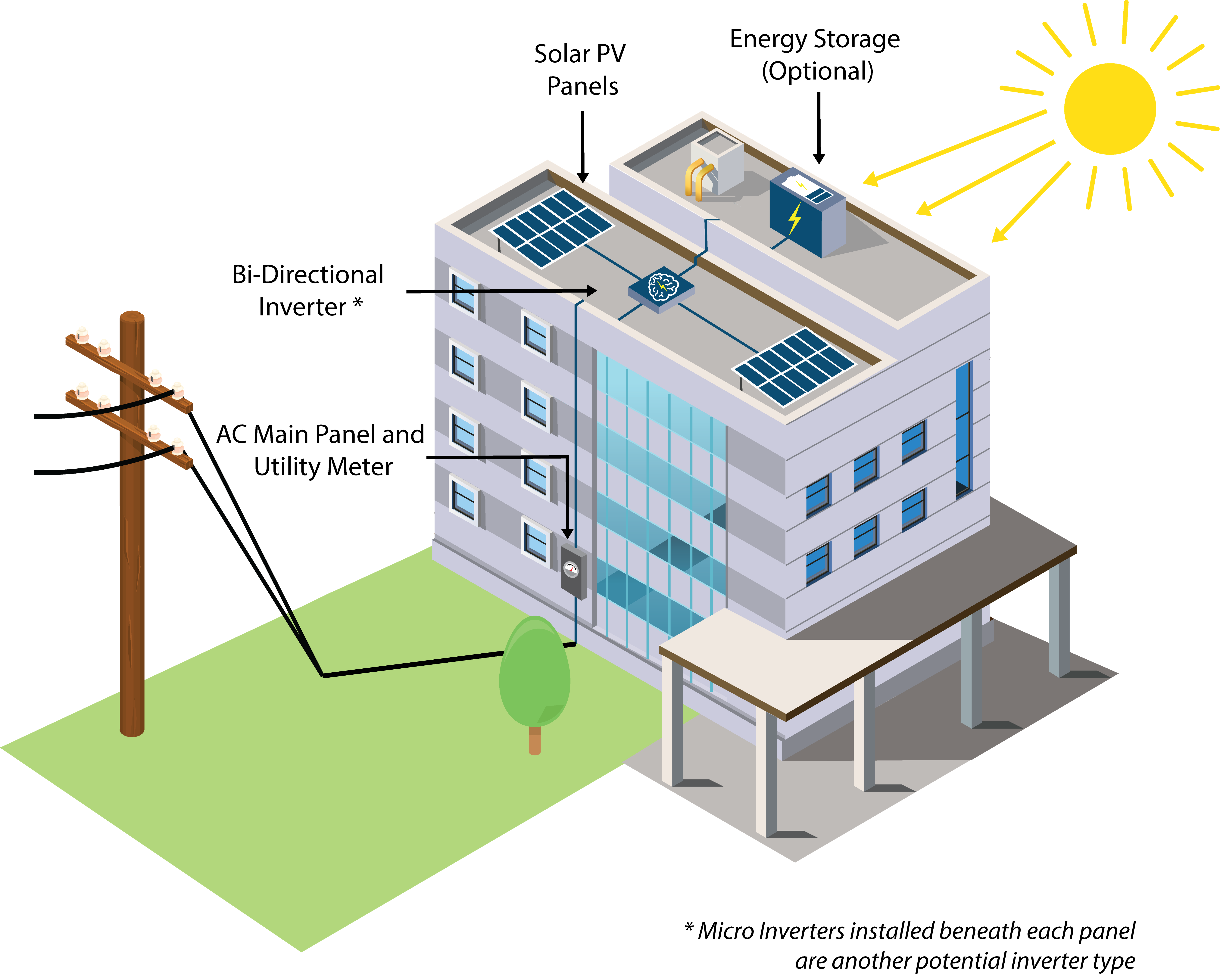Solar electricity helps property owners reduce their energy costs and their environmental impact.

Table of Contents
This page provides information and resources about putting solar on your commercial building, manufacturing facility, apartment building, or condominium.
Use the buttons to the right to navigate to their respective portions of this page.
Considering a smaller/residential solar electric project?
How It Works
Solar electric systems, also known as solar photovoltaics or solar PV, convert sunlight into electrical energy through an array of solar panels that connect to a building's electrical system or directly to the electrical grid.
As you consider whether solar electricity is right for your building or business, you can familiarize yourself with how the technology works. The U.S. Department of Energy offers a video on the basics of solar.

System Components
Grid Connection
In a grid-connected solar electric system, a building’s solar panels are connected to the local utility’s electrical grid. The building can continue to get some or all of its electricity from the grid. It can also “export” energy from its PV system to the grid when the PV produces more than the building needs.
Panels
Panels are made up of a series of individual solar cells that convert sunlight into direct current (DC) electricity. The higher the intensity of the sunlight striking the panels, the more electricity they produce. Once the electricity is produced, it flows to the inverter.
Inverter
The inverter converts the direct current (DC) electricity produced by the panels into alternating current (AC) electricity, which is the form that can be used in the building. Inverters include a range of technologies, from central inverters that convert the electricity from many solar panels, to microinverters that are attached to each individual panel in a system. In grid-connected systems, inverters are designed so that if power from the utility goes down, the PV system will shut down, too - a critical safety precaution for utility workers and public safety personnel.
Electrical Panel
The electrical panel is where electricity enters a building -- from either the solar panels or the utility grid. The electrical panel will automatically draw additional power from the utility when the PV system is unable to meet the building’s electricity demand. If the solar electric system is producing more electricity than needed, the electrical panel will send the excess electricity to the utility grid through a device called a net meter.
Energy Storage (optional)
An energy storage system can provide short-term storage for the power produced by your solar electric system. Several on-site technologies for energy storage, most notably lead acid and lithium ion batteries, are now available as add-ons to a solar installation. Energy storage systems help ensure power reliability during grid outages and can provide opportunities for improved on-site energy management, such as shaving peak demand. Primary factors to consider when evaluating a storage system include price, capacity, voltage, and life cycle
Incentives
Federal Incentives: Under the Inflation Reduction Act, Commercial Solar systems can now choose in between the Investment Tax Credit (ITC) and Production Tax Credit (PTC). Direct pay options may be available for certain tax-exempt entities, and new transferability possibilities can provide increased flexibility around financing. Adders are also available if the project meets certain criteria. For more details, you may refer to the Inflation Reduction Act: Solar Energy and Energy Storage Provisions Summary provided by the Solar Energy Industries Association (SEIA).
- Investment Tax Credit (ITC): Base ITC of 30% through 2033
- Production Tax Credit (PTC): PTC currently set at $0.026/kWh, adjusted each year for inflation by the IRS
Modified Accelerated Cost Recovery System (MACRS) Business owners can depreciate solar electric systems over a five-year schedule.
Solar Massachusetts Renewable Target (SMART) Program: A production-based incentive that is paid directly by investor-owned utilities in Massachusetts to solar electric system owners. SMART was launched by the Department of Energy Resources (DOER) in conjunction with investor-owned utilities. The selected Solar Program Administrator, CLEAResult, accepts and processes applications. Please see the DOER SMART website and the program administrator's SMART website for more information and a downloadable calculator to estimate SMART project incentives. To view the SMART Solar Block Status Update, see the Solar Program Administrator log-in page.
Net Metering Allows customers to receive credits on their utility bill for excess generation in any given month. The credits can then be applied during times when the system is not generating electricity. Net metering credit values depend on a number of factors including system size.
Municipal Light Plant Solar Rebate Programs: If you are served by a Municipal Light Plant (MLP), please contact your MLP directly for the most up to date information on incentives and programs.
Cost and Performance
The cost of buying a solar electric system can vary based on system size, location, equipment used and other factors.
The dashboard below can help business or property owners to explore the cost and performance of solar PV systems installed across Massachusetts installed under various state programs (such as SMART and Solar Carve Out). Prices listed below are shown as median values, which may not reflect unique project parameters. Pricing may vary based on project-specific factors, such as site condition or chosen equipment. MassCEC recommends comparing at least three installer quotes to help customers determine their best option.
This dashboard is based on the data included in our Solar PV Systems in MA Report (Excel format). Data about the performance of solar electric systems in Massachusetts can also be downloaded as part of the SREC Capacity Factor Report. (Note: This 54 MB Excel file may be slow to download). The 11-year average net capacity factor for solar PV systems in Massachusetts is 13.05 percent (2010 to 2020).
Solar + Storage
Energy storage, or batteries, can be a great complementary technology to install with solar PV. The pairing of solar PV system with energy storage is often referred to as solar + storage. With recent updates to state policies and incentive programs, combined with the potential electric bill savings and resilience benefits, solar + storage has become an increasingly attractive option for commercial property owners in Massachusetts. If you are interested in pursuing energy storage as part of a solar PV project, be sure to discuss your options as part of installer inquires and as you compare installer quotes.
MassCEC is actively involved in advancing energy storage as part of its Net Zero Grid focus.
Financing Options
Business or property owners have many options when it comes to financing the installation of solar electric systems. The more common financing options and their benefits are described below.
The Solar Project Builder, a tool developed with support from the US Department of Energy's Sunshot Initiative, can help you compare the benefits of different financing options for your project.
Other Resources
Note that some details in the provided resources may not apply directly to Massachusetts, and given the constantly-evolving policy and regulatory environment, the information provided may become outdated. If you have a specific question about the resources or on a topic not covered in these resources, please review the Frequently Asked Questions. Solar installers are also great resources for many topics, such as site assessment, understanding incentives, and analysis of financial feasibility.
Solar on Leased and Rental Buildings
Promoting Solar PV on Leased Buildings Guide: Better Buildings
Sharing the Sun: Solar Solutions for Landlords and Tenants: MassCEC
Solar for Apartments: Solar Market Pathways (Note: This guide has considerations relevant to Massachusetts, although it was developed as a California-specific resource)
Finding an Installer; Interconnection
Finding a Solar Installer: Clean Energy Lives Here, MassCEC
Seven Steps to Selecting a Commercial Solar PV Provider: Better Buildings
Distributed Generation and Interconnection in Massachusetts: Massachusetts Department of Energy Resources
Contracting
Model Lease and Power Purchasing Agreement: Solar Energy Industries Association
SEIA Consumer Protection Resources: Solar Energy Industries Association